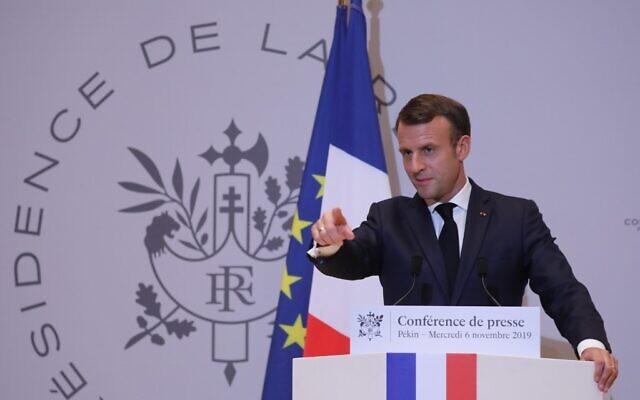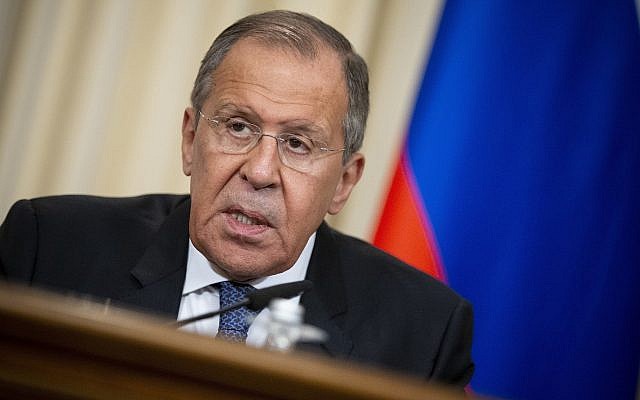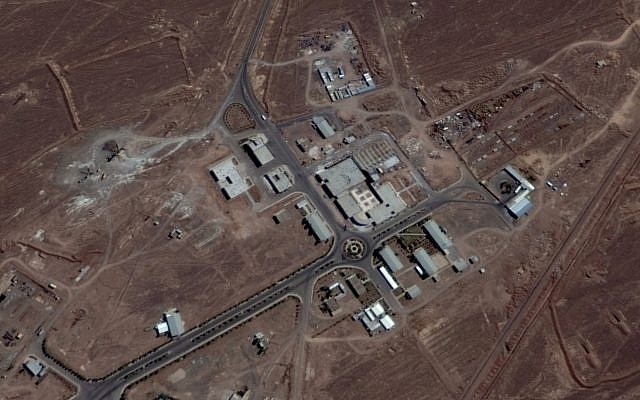French president urges easing sanctions while pressuring Iranians to negotiate a return; Russia calls on Tehran to uphold commitments to 2015 deal, blames US for situation

French President Emmanuel Macron on Wednesday said Iran’s decision to resume enrichment activity at a nuclear facility meant it had withdrawn from the troubled 2015 nuclear agreement with major powers.
Iran on Wednesday said it had begun inserting uranium gas into over 1,000 centrifuges at the Fordo nuclear facility, which under the JCPOA pact had turned into a research facility with no active enrichment.
“I think that for the first time, Iran has decided in an explicit and blunt manner to leave the JCPOA (nuclear) agreement, which marks a profound shift,” Macron said at a news conference during a trip to Beijing, according to a Reuters report.
Macron called the developments a “profound change” from Tehran’s previous position and a “grave” move.
“I will have discussions in the coming days, including with the Iranians, and we must collectively draw the consequences,” Macron said.
The next few weeks will be dedicated to increasing pressure on Iran to return within the framework of the pact, the French president said, adding that this must be “accompanied by an easing of some sanctions.”
“A return to normal can only take place if the United States and Iran agree to reopen a sort of trust agenda” and dialogue, Macron said.
He said he would discuss the issue with US President Donald Trump.
Russian Foreign Minister Sergei Lavrov called on Iran to fulfill its commitments to the nuclear deal, known formally as the Joint Comprehensive Plan of Action, Reuters reported.
Lavrov told reporters in Moscow that while he understands why Iran is reducing its adherence to the deal, he blames the US, which last year withdrew from the agreement, for the “extremely alarming” developments.

Tensions in the Persian Gulf region have been raised by the standoff between the US and Iran over the JCPOA. Macron has tried to mediate an end to the dispute but so far failed to get the two leaders to speak with each other.
Iranian President Hassan Rouhani, who announced the move Tuesday, confirmed on Twitter Wednesday that enrichment activity had restarted at Fordo, converting the underground facility back into an active enrichment center.
Iran’s 4th step in reducing its commitments under the JCPOA by injecting gas to 1044 centrifuges begins today. Thanks to US policy and its allies, Fordow will soon be back to full operation. https://t.co/Mpkk9d0BIp
— Hassan Rouhani (@HassanRouhani) Nobyembre 6, 2019
A centrifuge enriches uranium by rapidly spinning uranium hexafluoride gas.
Since the United States pulled out of the nuclear deal last year and imposed tough sanctions, Iran has taken a number of steps to curb its adherence to the international agreement in a bid to receive economic relief from the European signatories to the pact. The Trump administration wants to renegotiate the JCPOA which it says is not tight enough to prevent Iran from obtaining nuclear weapons, and does not address Iran’s ballistic missile program.
Reacting to Iran’s announcement Tuesday it would resume work at Fordo, the US accused Tehran of “nuclear extortion,” while Prime Minister Benjamin Netanyahu repeated his vow to prevent the Islamic Republic from acquiring nuclear weapons.
Iran acknowledged Fordo’s existence in 2009 amid a major pressure campaign by Western powers over Tehran’s nuclear program. The West feared Iran could use its program to build a nuclear weapon; Iran insists the program is for peaceful purposes.

The centrifuges at Fordo are first-generation IR-1s. The nuclear deal allows those at Fordo to spin without uranium gas, while allowing up to 5,060 IR-1s at the Natanz facility to enrich uranium.
Rouhani’s announcement came after Ali Akhbar Salehi, the head of the Atomic Energy Organization of Iran, said Monday that Tehran had doubled the number of advanced IR-6 centrifuges operating in the country to 60.
An IR-6 centrifuge can produce enriched uranium 10 times faster than an IR-1, Iranian officials say.
As of now, Iran is enriching uranium up to 4.5%, in violation of the accord’s limit of 3.67%. Enriched uranium at the 3.67% level is enough for peaceful pursuits but is far below weapons-grade levels of 90%. At the 4.5% level, it is enough to help power Iran’s Bushehr reactor, the country’s only nuclear power plant. Prior to the atomic deal, Iran only reached up to 20%.
Tehran has gone from producing some 450 grams (1 pound) of low-enriched uranium a day to 5 kilograms (11 pounds), Salehi said. Iran now holds over 500 kilograms (1,102 pounds) of low-enriched uranium, Salehi said. The deal had limited Iran to 300 kilograms (661 pounds).
As reported by The Times of Israel
